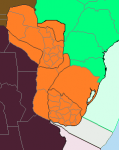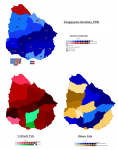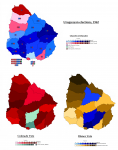The PoD for this is that the Great White Fleet doesn't call in at New Zealand, yes, really.
The Minister of Roads and Bridges
I was told this story by my father, who went to his grave insisting that it was false.
This was in 1909, during the long dry legislative holiday which came about when none of the men in power could decide whether shop workers deserved a half-day to themselves in a week, and when young Aloysius O’Leary was working on the railway.
The railway, you understand – the one between Wellington and Auckland through the volcano-blasted plateaus and the engineer-blasted cuttings in the hills. Some of the navigation-men would say that to build a railway through an almost unpopulated and almost certainly impassable section of the interior was a monument to Man’s arrogance, but even they did not realise quite how arrogant He was until they shook hands with the Minister of Roads and Bridges.
The Hapuawhenua Viaduct was, in point of fact, under the purview of the Minister of Public Works, but the Minister of Roads and Bridges was on a legislative holiday, and he wanted to be photographed near as many roads and bridges as he could find. Presumably he would display the slides at a magic lantern show in Wellington as an endurance challenge for his colleagues.
My father also liked to point out that the Minister of Roads and Bridges was simultaneously the Minister of Labour, but never showed any interest in being photographed next to labourers. But then, Dad was a bit of a Commo.
In any case, Aloysius O’Leary, as the weakest and most expendable member of his gang (and, although this ought not to cast doubt on the story, a young man heavily in hock to Jack Lee, the man who bootlegged spirits into the camp), was directed to look after the Minister during his visit, and to stay out of shot if at all possible.
The Viaduct was a masterpiece, even in its unfinished state. Rising above the gorge in a symphony of iron, it was the only viaduct on the line which was so beautifully curved. Somehow, all the straight lines of the girders and the rails were able to combine to create something graceful and constant – save, of course, for the gap in the middle where the final stage of construction was taking place. It provided a fine backdrop, as all the pressmen agreed before they returned, shivering from the wind, to the not-so-secret grog shop in the camp. This was the King Country, the land that was held by the Maori King until 1885, when the Government persuaded him to sell his birthright for a mess of pottage: or rather, for a local liquor ban and a free lifetime pass on the new railway that was to open his upland fastness to closer settlement.
The Maori themselves called it the Rohe Potae: supposedly ‘the land of the hat’, the story being that the King had dropped his top hat down on a map and claimed all the territory within the brim as his own.
Yes, the pressmen retreated to the camp, but the Minister of Roads and Bridges remained, staring out into the gorge like a man pondering whether or not to jump.
“Will you come back to the camp, sir?” asked Aloysius O’Leary, a touch of worry in his voice.
Wordlessly, the Minister moved, jerkily – as if being pulled by invisible hooks – in precisely the opposite direction. He stepped out towards the middle of the viaduct, his feet constantly tripping over rails and tools and sleepers. But he didn’t fall over, although he was a well-fed man with the red cheeks of a hipflask-owner. Aloysius, scared for the safety of his charge, rushed forward to support the Minister, but found that he was virtually weightless. He then tried to persuade him physically back to terra firma – but found that he was rigid and implacable. Our man had little choice but to go along with the decision that had been made, although he was not sure who was in charge of matters.
There should have been construction men working on the middle span, but they were occluded by a sudden fog that swelled unnoticed up the valley. All was muffled and unworldly, as commonly happens in such climactic conditions, and before long it seemed as if the only people in the world were Minister in his trance, and Aloysius O’Leary in his fear.
And a figure on the other side, who skipped and tiptoed along lengths of wooden scaffolding, and the occasional sleeper.
The Minister stopped on the very edge of the bridge, much to the relief of Aloysius, and so did the other figure (who seemed to be just as at home on the viaduct as anybody else) ten yards across the void. A greater contrast there could not have been: where the Minister of Roads and Bridges was well-built, the other was subtly sharp and wispy; where one was ruddy, the other’s skin (if you could call it skin) had a greenish pallor; where one was clad in waistcoat and watch-chain, the other wore either knightly armour, or barks and furs, or nothing at all, depending on your precise outlook on things. The Minister had a beard which Aloysius would, until that day, have described as ‘bushy’ - but the figure on the other side had
thorns and flowers in his hair.
“I am,” announced the Minister with a jolt of awakening, “the Minister of Roads and Bridges in His Majesty’s Government.”
“What a coincidence” replied the figure, or perhaps it was simply the wind in the trees on the valley floor. “Which King do you serve?”
“Why, King Edward, of course!” bellowed the Minister across the aching gap in the jaw of the viaduct. “The Seventh.”
To this last word the other took instinctive exception. It yelped in pain (or was it a bird of prey diving on a possum?) and covered its ears with hands that might well have been covered in lace gloves; them or spiderwebs. Recovering its composure, it adopted a mocking tone of voice which bore more malice than humour. “My, you people do get through them, don’t you? A remarkably careless species – you misplaced the fifth one four hundred years ago and you still haven’t asked us how he’s getting on.”
The Minister ignored the historical trivia and, as a true politician, brought his focus to bear on the salient questions of the matter at hand. “Who the devil are you and what do you want?” he screamed.
“I am, in a manner of speaking, your opposite number in the Court of King Oberon of Faerie, and I want you to abdicate your pretensions upon both his realm, and upon my portfolio.”
“
Your portfolio?” Aloysius had been shocked by the revelation that his grandmother’s tales had had some basis in fact; the Minister seemed to take all in his stride except for the assault upon his job security. “We are the only builders of roads and bridges in this country, I’ll have you know! We have spent seventy years building up this colony, opening up the land, and developing it for productive uses – and this is all underpinned by a scaffold of surveyors, bridge-builders and road-makers. The best the Maoris could ever manage is tracks and portages, and I don’t think there’s a ministerial portfolio in
that sort of thing!”
“Roads and bridges, roads and bridges,” mused the faerie with a pensive and imponderable smile on what, for want of a better word, we shall call his face, “they’re all a matter of perspective. Has it not occurred to you, Minister, that this is the sort of bridge that trolls live under? That the next one up the line might be the sort of bridge that is guarded by an old man who will ask three riddles before he lets you cross? Or that the roads you’ve built up in this high country are mazy, and rambling, and beguiling, and likely to lure a traveller from the straight and narrow? The mere workaday fact of who might or might not have built the bridge is irrelevant – what matters is who
made it.”
Aloysius was slightly offended by this remark. He had been quite proud of what labour he had managed to accomplish, and was almost certain that no trains would fall into the gorge on account of any of his riveting.
“Excuse me, my lord,” it seemed most appropriate to address him as such, “if you don’t mind me interrupting – on what basis does Oberon claim this land? I thought the fairies lived at the bottom of English gardens, and in the misty bogs of Ireland, if they existed at all.”
“This is the King Country,” said the faerie, with a simple shrug, “it belongs to the King. Whether that King is named Tawhiao, or Edward, or Oberon, is essentially immaterial. And if you enter the King Country with the right frame of mind, you might very well end up at the bottom of a garden in England – although I do not recommend it. I haven’t visited there in centuries, but even so I can’t wring the
damp from my soul. Oh – and no, it would be very foolish of you to imagine that any of our folk would do anything as tawdry as to
exist.”
“For the sake of argument,” the Minister said, “what would you have me do? All this talk of metaphysical mumbo-jumbo and abdicating pretensions is all very fine and dandy, but what of the hard tack? Set out your demands, and we shall negotiate – although be warned, Sir, for I am also the Minister of Labour, and I have a certain set of skills in this regard.”
The figure opposite snorted in a manner reminiscent of a geyser going off several miles away. “There shall be no negotiation. You shall tear up these twin swords of iron with which you assault our domain, or we will take a tithe.”
“A tithe?” asked Aloysius.
“Forty-four years from now, on one of your hallowed days, we shall deny passage into the Land of the Pot of Gold to one of your iron horses. The Whangaehu River will rise up against your invasion. Many will die.”
Now it was the turn of the Minister of Roads and Bridges to laugh. Unlike the simpering, sinister smiles of his opposite number, the Minister was given to guffaws. “Ha! One major accident in forty-four years is most certainly a price worth paying for progress! Now, if you’d threatened to derail a train before the next election, I might have been willing to talk business. But instead, fairy, I’ll give you a threat in return: this very moment, to the north, in the very heart of what you erroneously call your realm, our surveyors are plotting out a spiral of track, a great twisting mass of metal, with two tunnels and – best of all – as many horseshoe bends as you can count. You don’t like iron horseshoes, do you, fairy? Haha! That’s told him, I’ll wager!”
“It has indeed,” said the inhuman figure, “I grow bored of this discussion.” It gave a flick of a hand (or a swing of a supple branch) and the Minister of Roads and Bridges was suddenly transformed into a grunting, filthy pig. It snorted in surprise and lost its footing on the edge of the half-finished viaduct, and Aloysius O’Leary watched it fall slowly to the ground, uselessly trying to grasp girders and scaffolding with its trotters. He was powerless to do anything, although he suspected that the Minister would reach the ground in one piece, and would perhaps be turned back into a man by the kiss of a Princess.
The faerie shook his head sadly. He retreated into the mist without moving in any perceptible way. Aloysius, meanwhile, turned and picked his way back to more solid ground. The camp, and the grog-shop, and – presumably – his debts, had all disappeared. And when he turned behind him to look at the gap in the viaduct, it wasn’t there: the bridge was complete, and a train came across it which (by some bizarre witchcraft) produced no smoke. Not knowing what else to do, Aloysius O’Leary held his arm out, and was picked up by a befuddled but not unsympathetic driver.
Ever since, the southbound passenger trains on the North Island Main Trunk have customarily kept a seat empty for young Aloysius O’Leary, while drivers of the freight trains are welcome of the company in the cab, now that two-man running is a thing of the past. He’s always going south, is Aloysius O’Leary, but he never gets past Tangiwai. And although they now serve wine and beer on the Northern Explorer (the King Country voted to ‘go wet’ in the 1960s), he never touches a drop.
That’s what Dad told me, anyway.





